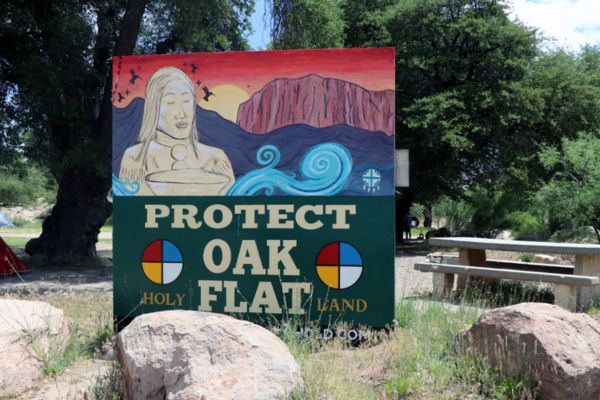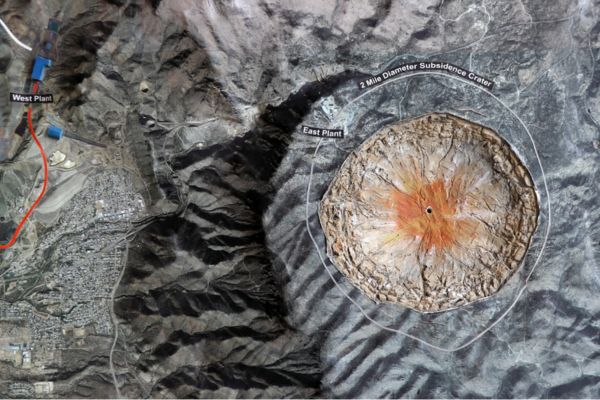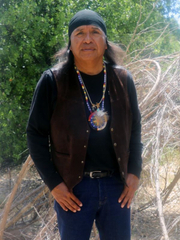
Gabby Menomin stands across from Lake Phalen in Saint Paul, where the first portion of the creek is to be daylighted. (photo: Sarah Whiting)
Just south of Lake Phalen in Saint Paul is a grassy area where people picnic and walk their dogs.
This story first appeared in Minnesota Women's Press. Republished by Native News Online with permission.
Further south, a strip mall leads into a residential area. Beyond that, I-94 emerges and the banks of the Mississippi River come into view.
Nearly 100 years ago, though, a powerful spring-fed creek flowed freely down this path from Lake Phalen to the river, where it formed a small delta on the Mississippi River floodplain. The waterway was an important travel corridor for Dakota people, and the land surrounding it was home to diverse wetland ecosystems.
Phalen Creek, as it was called by settlers, still exists. It flows through the depths of a concrete stormwater tunnel, entombed by developers in the 1930s.
In 1997, a group of neighbors founded the Lower Phalen Creek Project to bring awareness to the creek and its history. The nonprofit organization is now Native led and called Wakan Tipi Awanyankapi (WTA). The Bruce Vento Nature Sanctuary, Indian Mounds Regional Park, and Pig’s Eye Regional Park — all stewarded by the organization — are Dakota sacred sites.
Last year, WTA received $3.3 million in grant money to resurrect — or “daylight” — Phalen Creek. Minnesota Women’s Press spoke with the environmental restoration manager at WTA, Gabby Menomin (Forest County Potawatomi Community), about the project.
What was Phalen Creek like before it was put underground?
The creek was an important corridor for Dakota people, who would use it to canoe from the Mississippi River through Lake Phalen to a large wild rice bed that was once in White Bear Lake.
There were many medicinal and food plants along the creek. It was also the route people took to access Wakan Tipi Cave, which was important for a lot of different ceremonial purposes. Funerary services were performed at the cave before people were brought up to the mounds to be buried and interred. It was also a place for intertribal delegation and relationship-building, mostly because the creek was able to connect people with many inland areas.
During the beginning stages of settlement, settlers depended on the creek as a source of water. In the East Side settlement of Swede Hollow, immigrants relied on the creek and the springs as they made their encampments. When the creek was put underground, many people were affected.
The creek used to be fairly deep, and wide enough to fit several canoes. We’re not going to be able to replicate the creek exactly as it was historically because of the current landscape and some public safety concerns; we’re proposing a channel that will be two to six feet in some areas and not nearly as deep as it once was. The creek also won’t exactly follow its historic route because of existing infrastructure.
Why was the creek forced underground?
That was mainly for housing and development. The south end of Lake Phalen used to be wetland, and [developers] wanted to be able to control the water going through the East Side of Saint Paul to the Mississippi in order to build infrastructure.
The concrete storm pipe [that the creek flows through] is very large. [I’ve seen] pictures of builders standing in it, and it is taller than them. The pipe takes a direct route from Lake Phalen to the Mississippi, and stormwater interceptors connect along the way. Because of that, any pollutants from road runoff go straight into the Mississippi. [When the creek was above ground], the meanders in the creek settled sediment and pollutants and reduced the load into the Mississippi. Now, when there are large storm events, there is a rush of water heading right to the river.
Why is daylighting the creek important?
Culturally, it’s important for Dakota people, who were exiled from Minnesota. Since Phalen Creek was such an important corridor with abundant food and medicines, [being with the creek] is an opportunity for Dakota people to rebuild connection with the land.
With our environmental design, WTA is trying to incorporate as many medicinal and nutritional food plants as possible in order to mimic what would have been growing there. We would love to see ceremonies brought back along the creek.
A creek provides opportunities for polluted sediment to settle in lower-flowing turns in the stream, which will mitigate the pollution going into the Mississippi. Some of the plants that we plan to bring in are phytoremediators that can uptake certain pollutants. Cottonwoods, for example, are good at taking in heavy metals, and they love to live along creek beds.
In a dense urban area like the East Side, there’s an urban heat island effect. Surface water will also be able to provide localized cooling in the area.
What is the process of resurrecting the creek?
Currently, we are in the design phase for the first quarter mile of the creek and working with our water engineers and landscape architects. We are trying to figure out where the creek can run, determining what types of habitats we can support, and gathering information from the public to hear what kind of landscape features they would like to see, [such as] trails, benches, and gathering spaces. At the end of the design phase in summer of 2024, we will begin construction.
We will install a culvert and weir [a low dam that raises the water level upstream to regulate the creek’s flow] in this first portion of the creek, which will control the water flow from Lake Phalen, and then we will start the dredging process. Lake Phalen has massive amounts of water moving through it, so we have to regulate the flow so that it doesn’t wash out the creek and create a huge wetland in the neighborhood. Once we get the creek bed laid out, we will open up the weir and allow for the water to flow through.
During the construction phase for the creek, [we will get the community involved] in plantings. It’s really important for us to engage with the residents, and the indigenous community in Saint Paul and the Greater Twin Cities area, to see how they want to interact with the space.
We are still figuring out what habitats we can work with in this first quarter mile [of the creek]; we’ll have a better idea after we figure out the elevation and grading. There are three different habitat types that will be along the creek: riparian zones [a biome that occurs along a river or stream], oak savanna, and upland prairie.
Riparian species include the cottonwood, native cattails, bullrushes, and native reeds. In the prairie habitats, we will bring in things like big bluestem, little bluestem, porcupine grass, milkweed, bee balm, hyssop, and swamp milkweed. In the oak savanna habitat types, we’re going to be bringing in native sedges and grasses, and burr oaks. We are hoping to see fish transplanted, and we’re trying to figure out how we can integrate more migratory bird habitat.
How have waterways been intertwined with the history of settler colonialism in the region?
There is a long history of settlers trying to control water for agriculture and infrastructure purposes. It’s kind of amazing, this thought process of: “We’re going to completely change the flow of water. We’re going to put water underground in a pipe to make it go a certain route, and we’re going to be able to do what we want with the land after that.”
Water is such a powerful force; it has its own mind.
Because water is so powerful, there is a little wetland area that popped up about five years ago where the creek would have historically run near Lake Phalen. No matter how much people try to control water, it finds ways back. It knows where it wants to flow. The flooded areas in that lawn space are where we will be putting the first portion of the creek.
Restoration and creek daylighting are talked about as manipulating the land to make it look how it would have historically. A lot of that [perspective] comes from settler colonialism.
Lately I’ve been looking at restoration as not just about bringing habitats back — it is about healing the land while also healing yourself and the community.
Projects like this are a great way to get the community involved in being part of restoration efforts: doing the plantings, stewarding the projects after. [We want to] give people the opportunity to reconnect and start accepting nature as relatives.
Wetlands, marshes, and riparian zones are not considered good for property or for agriculture because the water levels are constantly fluctuating; they can be dry one year during a drought and then flood like crazy during a different year. The water routes are unpredictable.
But supporting those waterways is really important. There are ways these creeks and riparian zones can cohabitate with the current infrastructure. We have the technology, such as weir structures, to help control the water flow and levels so that these ecosystems can be brought back.












